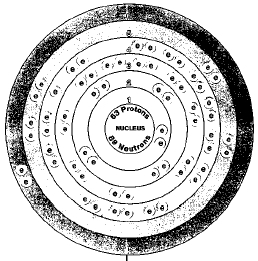EUROPIUM


Overview
Europium was discovered in 1901 by French chemist Eugene-Anatole Demarcay (1852-1904). Demarcay named the element after the continent of Europe. It was one of the Last of the rare earth elements discovered.
The term rare earth elements has long been used for elements in Row 6 of the periodic table, a chart that shows how chemical elements are related to each other. A better name for these elements is lanthanides. This name comes from the first element in Row 6, lanthanum. Rare earth elements are not especially rare, but were originally very difficult to separate from one another.
Europium is the most active of the lanthanides. It is more likely to react with other elements than the other rare earth elements.
Europium is quite expensive to produce, so it has few practical uses. It is used in television tubes and lasers.
SYMBOL
Eu
ATOMIC NUMBER
63
ATOMIC MASS
151.96
FAMILY
Lanthanide
rare earth metal)
PRONUNCIATION
yuh-RO-pea-um
Discovery and naming
In 1901, Demarcay was studying samarium, a new element that had been discovered over twenty years earlier. In his studies, Demarcay made an interesting discovery. The new element was not one, but two elements. Demarcay gave the original name of samarium to one, and the other he called europium, after the continent of Europe.
More than a century earlier, a heavy new mineral had been found near the town of Bastnas, Sweden, and given the name cerite.
Chemists found that cerite was a complex material. One hundred years of research revealed seven new elements in cerite. Europium was the last of these new elements to be identified.
Physical properties
Europium has a bright, shiny surface. It is steel gray and has a melting point of 826°C (1,520°F) and a boiling point of about 1,489°C (2,712°F). The density is 5.24 grams per cubic centimeter.
Europium has a strong tendency to absorb neutrons, making it useful in nuclear power production. A nuclear power plant produces electricity from the energy released by nuclear fission. Slow-moving neutrons collide with uranium or Plutonium atoms, breaking them apart and releasing energy as heat. The amount of energy produced in a nuclear power plant is controlled by the number of neutrons present. Europium is used to absorb neutrons in this kind of control system.
Chemical properties
Europium is the most active of the lanthanides. It reacts quickly with water to give off hydrogen. It also reacts strongly with oxygen in the air, catching fire spontaneously. Scientists must use great care in handling the metal.
Occurrence in nature
Europium is not abundant in the Earth's surface. It is thought to occur at a concentration of no more than about one part per million. That makes it one of the least abundant of the rare earth elements. The study of light from the Sun and certain stars indicates that europium is present in these bodies as well.
The most common ores of europium are monazite, bastnasite, and gadolinite.
Isotopes
Two naturally occurring isotopes of europium exist, europium-151 and europium-153. Isotopes are two or more forms of an element. Isotopes differ from each other according to their mass number. The number written to the right of the element's name is the mass number. The mass number represents the number of protons plus neutrons in the nucleus of an atom of the element. The number of protons determines the element, but the number of neutrons in the atom of any one element can vary. Each variation is an isotope.
A number of radioactive isotopes of europium have also been prepared. A radioactive isotope is one that breaks apart and gives off some form of radiation. Radioactive isotopes are produced when very small particles are fired at atoms. These particles stick in the atoms and make them radioactive. None of the radioactive isotopes of europium has any commercial use.
Extraction
Europium is prepared by heating its oxide with lanthanum metal:
Europium metal is quite expensive to make and sells for about $3,000 to $4,500 a kilogram ($1,350 to $2,000 a pound).
Uses
There are no commercially important uses for europium metal.
Compounds
The most common use of europium compounds is in making phosphors. A phosphor is a material that shines when struck by electrons. The color of the phosphor depends on the elements from which it is made. Phosphors containing europium compounds give off red light. The red color on a television screen, for example, may be produced by phosphors containing europium oxide. Europium oxide is a compound made of europium metal and oxygen.
Europium reacts strongly with oxygen in the air, catching fire spontaneously.
Europium oxide phosphors are also used in printing postage stamps. These phosphors make it possible for machines to "read" a stamp and know what its value is. If the wrong stamp is on a letter, the machine can tell from reading the phosphor. The machine will then send the letter back to the person who mailed it.
Health effects
Except for its tendency to catch fire, little information is available on the health effects of europium. In general, it is regarded as toxic and must be handled with great caution.